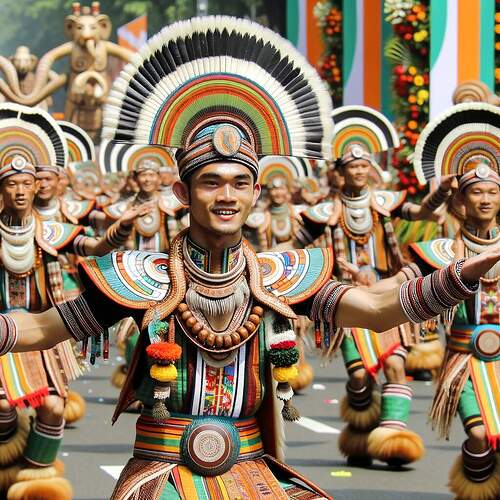which dance form is showcased by a cultural troupe from northeastern india during the parade
Which dance form is showcased by a cultural troupe from northeastern India during the parade?
Answer:
Northeastern India is a region rich in cultural diversity and home to a wide variety of traditional dances, each with its unique style, significance, and history. During parades, especially those celebrating cultural festivals or national events like Republic Day, these dance forms are often showcased to highlight the vibrant heritage of the region. Here are some prominent dance forms from northeastern India that might be presented by a cultural troupe:
1. Bihu Dance of Assam
-
Origin and Significance:
Bihu is one of the most celebrated dance forms in Assam, primarily associated with the Bihu festival, which marks the Assamese New Year and the beginning of the harvesting season. It is a vibrant and energetic dance performed by both men and women. -
Costume and Music:
Performers traditionally wear colorful costumes, with women donning the “Mekhela Chador” and men in dhotis and gamosas. The dance is accompanied by traditional Assamese musical instruments like dhol, pepa, and taal. -
Dance Characteristics:
The Bihu dance is characterized by brisk steps, rapid hand movements, and expressive gestures, reflecting joy and festivity.
2. Manipuri Dance of Manipur
-
Source and Background:
Originating from the state of Manipur, Manipuri dance is a classical dance form known for its intricate movements and themes largely centered around the life of Lord Krishna and Radha, as featured in the Ras Lila. -
Costume and Presentation:
Dancers are dressed in traditional attire, with women wearing ‘Patloi’ and men in ‘Dhoti’. The costumes are vibrant, with ornamented skirts and veils adding to the dance’s visual appeal. -
Dance Traits:
Manipuri dance is marked by its graceful hand movements, gentle footwork, and emphasis on facial expressions, creating an aura of divine elegance.
3. Naga Dances
-
Origin and Context:
The Naga tribes from Nagaland each have distinctive dance styles that are typically performed during festivals like the Hornbill Festival, which is an integral part of their cultural expression. -
Attire and Instruments:
Performers often wear traditional warrior attire adorned with feathers, beads, and shells. The dances are accompanied by rhythmic drumming and chants. -
Dance Specifics:
Naga dances usually feature vigorous jumping, synchronized movements, and formations that represent tribal folklore, history, and the spirit of the community.
4. Sattriya Dance of Assam
-
Historical Background:
Recognized as one of India’s classical dance forms, Sattriya originated in the monasteries or ‘satras’ of Assam as a way to propagate Vaishnavism. It was introduced by the saint-scholar Sankardeva in the 15th century. -
Costume and Performance:
Dancers wear elaborate costumes, traditionally white, with male dancers in ‘Dhoti’ and ‘Chadar’ and female dancers in ‘Ati Bheka’. Performances often depict stories from Hindu mythology. -
Dance Features:
Sattriya dance is characterized by expressive facial gestures, hand movements, and rhythmic footwork, performed as a homage to the deities.
5. Wangala Dance of Meghalaya
-
Origin and Celebration:
This traditional dance of the Garo tribe in Meghalaya is performed during the Wangala festival, a harvest festival celebrating the new year with gratitude to the deity Saljong. -
Cultural Attire:
Performers wear traditional costumes embellished with beadwork and feathers. The dance ensembles often include traditional drums and brass instruments. -
Characteristics:
The Wangala dance is rhythmic and involves large groups dancing in unison, symbolizing strength and communal harmony.
6. Bamboo Dance (Cheraw) of Mizoram
-
Traditional Roots:
Cheraw is one of Mizoram’s most famous traditional dances, closely associated with the harvest festival. It is believed to bring prosperity and celebrate life’s milestones. -
Attire and Props:
Dancers, dressed in traditional Mizo attire, dance between and around moving bamboo poles held by enablers, creating a mesmerizing symphony of rhythm and movement. -
Distinctive Elements:
The dance demands agility and coordination, with dancers stepping in time to the clapping of bamboo sticks, symbolizing the flow of nature.
Why these dances enhance parade performances
-
Cultural Showcasing: These dances not only entertain but also educate audiences about the diverse cultural heritage of northeastern India, fostering understanding and appreciation.
-
Diverse Representation: Each dance form represents a unique ethnic or tribal identity, showcasing the region’s multicultural fabric during a parade.
-
Visual and Auditory Appeal: Vibrant costumes, traditional music, and energetic performances combine to create a spectacular visual and auditory experience for parade audiences.
These traditional dances form an integral part of celebrations and offer a glimpse into the rich tapestry of cultural expressions inherent to northeastern India. They not only preserve these timeless traditions but also celebrate them on platforms such as large parades and cultural festivals, ensuring that today’s audience witnesses the living heritage of the region.
If you’re interested in learning more about any of these dance forms, let me know, and I can provide further details or help with resources!
